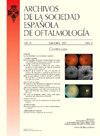传染性角膜炎的病因
Q3 Medicine
Archivos De La Sociedad Espanola De Oftalmologia
Pub Date : 2025-04-01
DOI:10.1016/j.oftal.2024.11.003
引用次数: 0
摘要
目的分析我院感染性角膜炎的病因。材料与方法回顾性分析近9年(2014年1月- 2022年12月)检测到一种角膜炎产生微生物的患者病历。样品通过角膜刮痧获得,并在非选择性培养基中播种。细菌和真菌鉴定采用质谱法,病毒鉴定采用聚合酶链反应法。使用盘片抗生素谱、est或肉汤微量稀释系统获得敏感性。结果共处理416例患者角膜刮擦标本433份。阳性196份(44.3%)。平均年龄为55岁,其中51%为女性。在病原学方面,我们发现以下分离株:革兰氏阳性菌(N = 83;44%),其中以金黄色葡萄球菌(N = 33)、凝固酶阴性葡萄球菌(N = 26)为主,以表皮葡萄球菌最多(N = 19);革兰氏阴性菌(N = 67;35%),包括:铜绿假单胞菌(N = 31), 42%与使用隐形眼镜和肠杆菌(N = 16)有关;厌氧菌(N = 19),其中18株为痤疮表皮杆菌。病毒病原学(N = 10):单纯疱疹1型(N = 7)和水痘带状疱疹病毒(N = 3)。真菌病原学(N = 13),突出念珠菌(N = 10)。结论感染性角膜炎的主要病原体是金黄色葡萄球菌和铜绿假单胞菌。在44.3%的样品中检测到病原体,因此对这些样品进行微生物学分析是非常可取的。本文章由计算机程序翻译,如有差异,请以英文原文为准。
Etiología de la queratitis infecciosa
Objetives
Analyze the etiology of infectious keratitis in our hospital.
Material and methods
Retrospective study in which the medical records of patients were reviewed in which a keratitis-producing microorganism was detected during the last 9 years (January 2014-December 2022). The sample was obtained by corneal scraping and seeded in non-selective media. Bacterial and fungal identification was carried out by mass spectrometry and viral identification by polymerase chain reaction. Sensitivity was obtained using disk-plate antibiograms, Etest or broth microdilution systems.
Results
A total of 433 samples of corneal scrapings belonging to 416 patients were processed. Of the total samples, 196 were positive (44,3%). The average age was 55 years, with 51% being women. Regarding the etiology, we found the following isolates: Gram-positive bacteria (N = 83; 44%), highlighting Staphylococcus aureus (N = 33), coagulase-negative staphylococci (N = 26), being Staphylococcus epidermidis the most frequent (N = 19); gram-negative bacteria (N = 67; 35%), including: Pseudomonas aeruginosa (N = 31), 42% associated with the use of contact lenses and enterobacterales (N = 16); anaerobes (N = 19), which 18 isolates were Cutibacterium acnes. Regarding viral etiology (N = 10): herpes simple type 1 (N = 7) and varicella-zoster virus (N = 3). Finally, the fungal etiology (N = 13), highlighting Candida spp. (N = 10).
Conclusions
The main agents of infectious keratitis are Staphylococcus aureus and Pseudomonas aeruginosa. The causative agent was detected in 44,3% of the samples, so microbiological analysis of these samples is highly advisable.
求助全文
通过发布文献求助,成功后即可免费获取论文全文。
去求助
来源期刊

Archivos De La Sociedad Espanola De Oftalmologia
Medicine-Ophthalmology
CiteScore
1.20
自引率
0.00%
发文量
109
审稿时长
78 days
期刊介绍:
La revista Archivos de la Sociedad Española de Oftalmología, editada mensualmente por la propia Sociedad, tiene como objetivo publicar trabajos de investigación básica y clínica como artículos originales; casos clínicos, innovaciones técnicas y correlaciones clinicopatológicas en forma de comunicaciones cortas; editoriales; revisiones; cartas al editor; comentarios de libros; información de eventos; noticias personales y anuncios comerciales, así como trabajos de temas históricos y motivos inconográficos relacionados con la Oftalmología. El título abreviado es Arch Soc Esp Oftalmol, y debe ser utilizado en bibliografías, notas a pie de página y referencias bibliográficas.
 求助内容:
求助内容: 应助结果提醒方式:
应助结果提醒方式:


